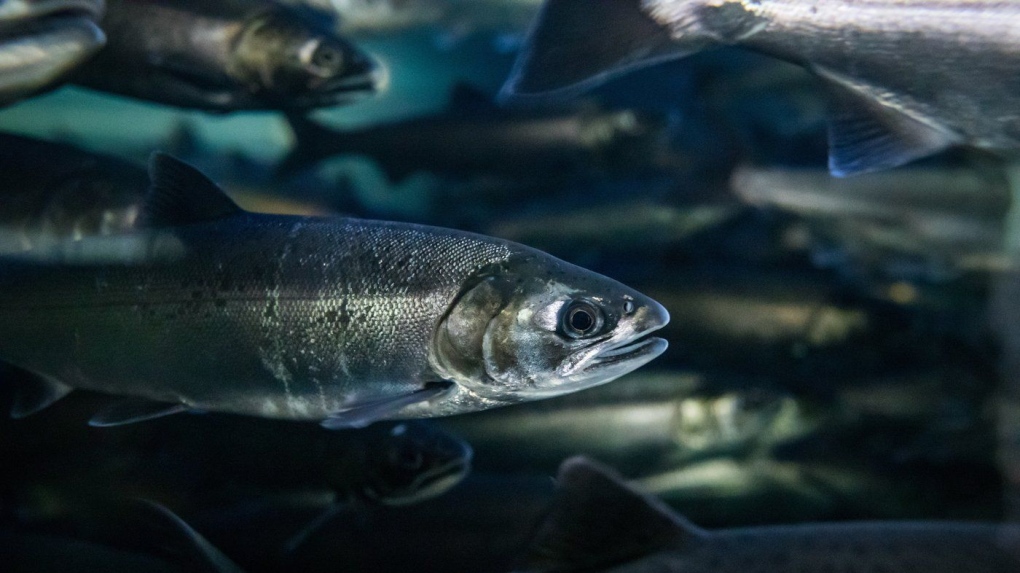Changing salmon hatchery release practices can improve survival rates: B.C. study
 Coho salmon swim at the Fisheries and Oceans Canada Capilano River Hatchery, in North Vancouver, on Friday July 5, 2019. A first-of-its kind study in British Columbia suggests salmon hatcheries could improve survival rates by optimizing the weight of the juvenile fish and the timing of their release. THE CANADIAN PRESS/Darryl Dyck
Coho salmon swim at the Fisheries and Oceans Canada Capilano River Hatchery, in North Vancouver, on Friday July 5, 2019. A first-of-its kind study in British Columbia suggests salmon hatcheries could improve survival rates by optimizing the weight of the juvenile fish and the timing of their release. THE CANADIAN PRESS/Darryl Dyck
A first-of-its kind study in British Columbia suggests salmon hatcheries could improve survival rates by optimizing the weight of the juvenile fish and the timing of their release.
More than five billion juvenile salmon are released from hatcheries into the North Pacific Ocean each year, with about six per cent coming from B.C. and Yukon.
The hatcheries are aimed at stabilizing declining populations of wild salmon while keeping fisheries afloat, but the study says there’s a lack of robust scientific assessment of their overall efficacy for conservation purposes.
The study published in the Canadian Journal of Fisheries and Aquatic Sciences analyzed data from 21 chinook and 16 coho hatcheries in B.C. over the last two decades, finding higher survival rates were linked to heavier weights upon release.
For ocean-type chinook, it found the average maximum survival stemmed from releases six to 27 days earlier than historical averages for most of the hatcheries.
Meanwhile, coho survival rates could be improved by releasing the fish eight to 33 days later than the historical average.
The locations of hatcheries in the study ranged from Prince George, Revelstoke and the Fraser Valley, to the Sunshine Coast and Vancouver Island.
The findings do not represent a one-size-fits-all solution across hatcheries, says lead author Sam James, a biologist with the Vancouver-based Pacific Salmon Foundation.
The study found the greatest improvements in salmon survival rates were generally predicted from a combination of the optimal weight and timing of release.
Optimizing hatchery release practices could increase salmon returns by six to as much as 245 per cent for chinook and five to 160 per cent for coho, the study suggests.
However, James says it's important to look at full range of those possibilities, rather than focusing on the highest potential increases.
There were many locations for which changes were not expected to yield major increases in salmon survival and returns, and there was a high degree of uncertainty in the modelling around the ranges of potential gains, she says.
James says the study is unique because the researchers used an approach that examined numerous hatcheries as a group, allowing them to "unveil" the overarching relationships between release practices and survival while accounting for hatchery-specific deviations from the trends they identified.
Isobel Pearsall, the director of the Pacific Salmon Foundation’s marine science program, says the study is the first in B.C. to examine the efficacy of release practices on that larger scale.
“There were a couple of reports, lots of scattered information,” she says.
But there was no pre-existing larger study looking at different hatcheries together, and identifying release practices that could support higher survival rates, she says.
Salmon face many threats, James says, and while hatcheries cannot control conditions in the ocean, they can set the fish up for greater success with the right release practices.
The study did not consider economic factors, and additional expenses may be associated with optimizing release practices, Pearsall adds.
For example, it may be a challenge for hatcheries to increase the weight of juvenile chinook while also aiming to release them earlier, she says.
The researchers took into account the effects of other factors that can affect salmon survival rates, such as predators and environmental conditions, in order to focus their analysis on the role of release practices, she notes.
This report by The Canadian Press was first published March 24, 2023.
CTVNews.ca Top Stories

B.C. tenants evicted for landlord's use after refusing large rent increase to take over neighbouring suite
Ashley Dickey and her mother rented part of the same Coquitlam duplex in three different decades under three different landlords.
Mountain guide dies after falling into a crevasse in Banff National Park
A man who fell into a crevasse while leading a backcountry ski group deep in the Canadian Rockies has died.
Expert warns of food consumption habits amid rising prices
A new survey by Dalhousie University's Agri-Food Analytics Lab asked Canadians about their food consumption habits amid rising prices.
MPP Sarah Jama asked to leave Ontario legislature for wearing keffiyeh
MPP Sarah Jama was asked to leave the Legislative Assembly of Ontario by House Speaker Ted Arnott on Thursday for wearing a keffiyeh, a garment which has been banned at Queen’s Park.
Charlie Woods, son of Tiger, shoots 81 in U.S. Open qualifier
Charlie Woods failed to advance in a U.S. Open local qualifying event Thursday, shooting a 9-over 81 at Legacy Golf & Tennis Club.
Ex-tabloid publisher testifies he scooped up possibly damaging tales to shield his old friend Trump
As Donald Trump was running for president in 2016, his old friend at the National Enquirer was scooping up potentially damaging stories about the candidate and paying out tens of thousands of dollars to keep them from the public eye.
Here's why provinces aren't following Saskatchewan's lead on the carbon tax home heating fight
After Prime Minister Justin Trudeau said the federal government would still send Canada Carbon Rebate cheques to Saskatchewan residents, despite Saskatchewan Premier Scott Moe's decision to stop collecting the carbon tax on natural gas or home heating, questions were raised about whether other provinces would follow suit. CTV News reached out across the country and here's what we found out.
Montreal actress calls Weinstein ruling 'discouraging' but not surprising
A Montreal actress, who has previously detailed incidents she had with disgraced Hollywood producer Harvey Weinstein, says a New York Court of Appeals decision overturning his 2020 rape conviction is 'discouraging' but not surprising.
Caleb Williams, Jayden Daniels and Drake Maye make it four NFL drafts with quarterbacks going 1-3
Caleb Williams is heading to the Windy City, aiming to become the franchise quarterback Chicago has sought for decades.































